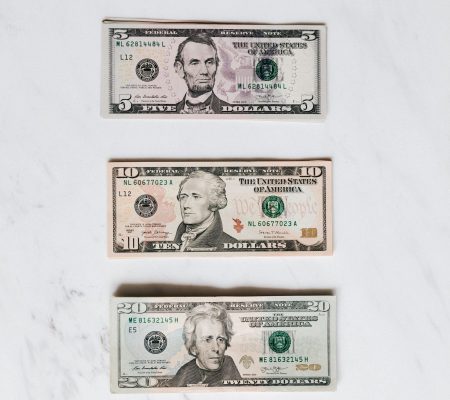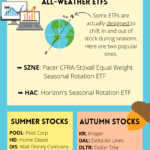Last updated on February 23rd, 2022 , 09:21 am

After opening a Roth IRA account, many investors feel overwhelmed by the almost inexhaustible choices of investment options. This is in contrast to a standard company-sponsored 401k plan, where the options are often limited to one or two dozen funds.
The fewer choices you have, the less difficult your investing decisions become. The introduction of the “target-date” retirement fund in 401k plans made this process even easier, allowing investors access to complete diversification by only investing in a single fund managed for their selected year of retirement.
Though the lack of choices offered by 401k plans may be relieving at first, their limitations are surely felt over time. Company-sponsored plans are geared towards the masses, not the individual. Individual investors are like snowflakes in that everyone has different goals, ambitions, and motivations for their money. How can one align these individual preferences with so few choices?
If you’re a clean energy advocate, you have no option to invest in these companies; for an investor who believes tech is the future, there are seldom funds devoted solely to the technology industry; if you want to play it safe and invest solely in high dividend-paying ETFs, your company plan is likely to come up short.
Highlights
- Roth IRA’s offer more flexibility than traditional IRAs and 401k plans.
- Withdrawals from Roth IRAs are 100% tax free
- Vanguard’s “VTI” ETF offers exposure to over 3,500 US companies.
- Vanguard’s”VXUS” ETF offers exposure to over 7,000 international stocks.
Roth IRA
This is when the Roth IRA comes in handy. Roth IRA contributions are made with after-tax dollars but withdrawals are 100% tax-free. These retirement vehicles are perfect to supplement your 401k. With a Roth IRA, you have complete power over your money. You have choices. Many, many choices. There are over 6,000 publicly-traded companies on the New York Stock Exchange and the Nasdaq Stock Exchange alone. How do you decide what to invest in?
If you’re reading this article, you’re already ahead of the game by focusing on ETFs (exchange-traded funds). The vast majority of stockpickers underperform the market. Focusing on categories and sectors rather than individual companies has proven to be the best approach to long-term investing.
But limiting ourselves to ETFs doesn’t really solve our problem either. There are thousands of them as well!
The popularity of ETFs has been skyrocketing past mutual funds in recent years for good reason. Their fees are usually lower, they provide for better liquidity (you don’t have to wait until the market closes to buy/sell an ETF), and ETFs have no minimum investment requirements.
So let’s get right into it. Here are a few ETF reviews by projectfinance to get you started in your search.
Note! The “Expense Ratio”, represented on a percentile basis, is the total fee an investor must pay the issuer to hold an ETF. This fee is not withdrawn from an investor’s account but taken out of the ETFs net asset value (NAV).
- Category: Broad-Based Market ETF
- Expense Ratio: 0.03%
- Dividend Yield: 1.30%
The correlation between market categories is no longer as strong as it once was. It isn’t uncommon in this new market for the Dow Jones Industrial Average to be up 3% while the Nasdaq is down 1%. In these times of diversion and volatility, the risk-on investor wants to have exposure to everything. Since it doesn’t seem volatility is going anywhere for a while, a total market ETF would work perfectly in your Roth IRA.
Vanguard’s Total Stock Market ETF (VTI) is one of the most popular ETFs out there. It has it all: a basket of 3,755 US growth and value stocks diversified across large-cap, mid-cap, and small-cap classes. For those new to investing, or those who just don’t want to spend the time deciding what to invest in, VTI is a practical and smart investment vehicle.
The best part about VTI is its fee. Its meager expense ratio of 0.03% puts traditional mutual funds to shame, who charge on average more than 1.40% in fees! Though 1.4% may not seem like much now, when your retirement savings start to get into the six and seven digits area, you will definitely feel it.
The VTI ETF, however, only has US stocks within its portfolio – what about international stocks? A well-diversified portfolio has exposure to both. Let’s take a look at VTI’s international cousin next.
- Category: Broad-Based International ETF
- Expense Ratio: 0.08%
- Dividend Yield: 2%
Vanguard’s Total International Stock ETF (VXUS) is for global stocks what VTI is for US stocks. VXUS contains a basket of more than 7,000 stocks across the international spectrum, ranging from developed countries to emerging markets. Perhaps this wide diversification of companies helps to make up for VXUS’s slightly higher management fee of .08%.
This fee is still incredibly low, considering the average ETF management fee is just over 0.50%. Remembering the average mutual fund fee is 1.40%, 0.08% doesn’t sound so bad. Isn’t that easier and cheaper than purchasing the 7,000+ stocks on your own?
If you were only interested in investing in equities, you could buy VTI and VXUS and call it a day knowing you had exposure to almost every investment-worthy company in the entire world for minuscule fees.
But most investors want to diversify their asset classes to include bonds. Bonds have not been doing great recently. In light of today’s growing inflation and low-interest rates, let’s next take a look at an ETF that makes sense.
- Category: Broad-Based International ETF
- Expense Ratio: 0.08%
- Dividend Yield: 2%

Most professionals agree that all retirement accounts should have some exposure to bond funds. What percent of your retirement should be in bonds? Projectfinance dedicated an entire article to answer this question: What’s the Best Stock to Bond Ratio for Your Age?
iShares TIPS Bond ETF (TIP) is a dynamic ETF that provides an amazing hedge against inflation.
Over the past year, interest rates have been very low and bond ETFs have been losing money. The TIPS ETF, however, has been doing very well. This is because it is linked to the Consumer Price Index (CPI), thus hedging itself against these rising prices. When CPI increases, so do the coupon payments of the securities which compose TIP. This means the value of TIP and its dividends go up.
On the contrary, in times of lower prices, treasury inflation-protected securities like the TIP ETF will underperform. Therefore, this ETF must be watched closely and adjusted appropriately to changing economic conditions.
If you’re truly concerned about inflation, check out our article Inflation and the Stock Market: 5 Sectors to Consider for a few more investment ideas.
- Category: Real Estate
- Expense Ratio: 0.48%
- Dividend Yield: 2.62%
The past year has been a wild ride for real estate. While commercial markets have been getting clobbered like never before, residential real estate has rarely been better. It is because of this REZ is next on our list of top seven ETF pics for your Roth IRA in 2021.
Now let’s take a look at that lofty fee of .48%. That expense ratio is 16x higher than that of VTI! So how did it make the list? Sometimes, it makes sense to pay a higher fee if the gains outweigh the expense.
The REZ ETF is appropriate for the more active investor as soaring residential real estate values may very well prove to be temporary. If you’re more “set it and forget it” minded, a more broad-based real estate ETF, such as The Real Estate Select Sector SPDR® Fund (XLRE) may be more appropriate. This ETF tracks the real estate sector of the S&P 500.
If you’d like to read up on how various real estate investment trusts (REITs) work, we have you covered there too.
Coming as a surprise for many, US small-cap (small-capitalization companies) stocks lead the post-pandemic equity recovery. This was primarily a result of extremely low Treasury yields. Generally speaking, smaller companies rely on debt more than larger companies. When debt is cheap (as it is now), the cost of their borrowing is reduced, thus their profits increase.
Assuming the Fed officials are correct in their presuming inflation will not pose a permanent threat on the markets, the future of small caps is promising.
The VB ETF offered by Vanguard is a great option for an investor looking for small-cap exposure. It is a “blend” ETF, meaning it is composed of both growth and value small-cap stocks.
VB stands out on the list of other small-cap ETFs because of its performance and a very low expense ratio of .05%.
When an investor thinks of a small-cap ETF, iShares Russell 2000 ETF IWM (IWM) often comes to mind. The expense ratio for IWM currently sits at 0.19%! That’s almost 4x higher than that of VB. Additionally, VB has historically outperformed IWM. It’s a no-brainer. VB wins here.
Mid-cap (Middle Capitalization) ETFs are often a neglected component of the new DIY investor’s portfolio. Mid-cap companies are not up-and-coming, nor are they established. The market capitalization of mid-cap companies ranges between $2 and $10 billion, that sweet spot that divides them from their small and large siblings.
For an investor looking to diversify their Roth IRA, exposure to mid-caps make financial sense. In a normal performing market, the profit/loss profiles of mid-caps tend to fall right in the middle of small and large-cap companies.
Vanguard wins this category again with its Mid-Cap ETF VO because of its incredibly low expense ratio of 0.04%.
- Category: Healthcare/Biotechnology
- Expense Ratio: 0.75%
- Dividend Yield: 0.97%

Covid-19 has changed healthcare forever. Cathie Wood’s Genomic Revolution ETF Fund hopes to capitalize on these changes, as well as the future technology of medicine. To her credit, the Ark Innovation ETFs have performed superfluously well throughout the pandemic.
Lately, however, the ETFs of the Ark family have been struggling, and the Genomic Revolution ETF ARKG is no exception. It is too early to tell whether or not this is a great buying opportunity for ARKG. All we do know for certain is that change is coming in this space, and the keen eye of Cathie Wood will be there watching it all unravel very closely.
Let’s get this out of the way – the fee for ARKG is high, cash burningly high. Coming in at 0.75%, the management fees of ARKG is the highest on our list, and last for that reason. However, as with our REZ ETF pick, sometimes performance justifies the expense. There is no better case for this than ARKG. On the tail of Covid-19, ARKG has doubled the gains of its representative index.
For an investor with a long-term horizon and a strong stomach (ARKG is notoriously volatile), this ETF could potentially pay off big-time in your Roth IRA down the road.
Final Word
There are over 2 thousand ETFs in the US alone. Every single one of them is different. The only way to determine which ones are a good fit for your Roth IRA is to do the research. Find categories and sectors you believe in, then research, research, research.
There are some great free resources out there to help you, such as Morningstar. I never buy an ETF before first looking it up in Morningstar first to check its expense ratio and relative category performance.



